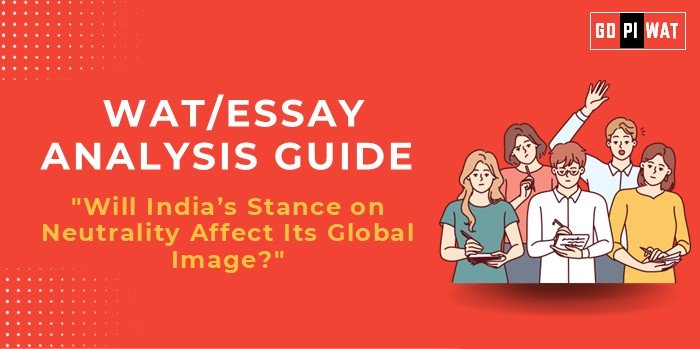📋 WAT/Essay Analysis Guide: “Will India’s Stance on Neutrality Affect Its Global Image?”
🌟 Understanding the Topic’s Importance
India’s neutrality highlights a balance between realpolitik and idealism, resonating with core B-school themes like strategic decision-making, global leadership, and stakeholder management.
📝 Effective Planning and Writing
- ⏳ Time Allocation:
- 🕒 Planning: 5 minutes
- ✍️ Writing: 20 minutes
- 🔍 Review: 5 minutes
- 💡 Preparation Tips:
- 🔍 Identify key stakeholders and their interests.
- 📊 Note relevant statistics, e.g., energy imports and defense dependencies.
💡 Introduction Techniques for Essays
- ✨ Contrast Approach:
“While India maintains neutrality in global conflicts, it faces growing criticism for moral ambiguity, raising questions about its leadership aspirations.”
- 📜 Historical Lens:
“Rooted in the Non-Aligned Movement, India’s neutrality policy now adapts to 21st-century multipolar geopolitics, balancing energy needs with global expectations.”
🔍 Structuring the Essay Body
- 🏆 Achievements: India’s neutral stance allows energy security through discounted Russian oil imports and positions it as a mediator in global conflicts.
- ⚖️ Challenges with Comparative Analysis: Balancing ties with the West and Russia is fraught with risks, as seen in NATO’s criticism and comparisons to Turkey’s model of strategic autonomy.
- 🌍 Future Outlook: India can redefine neutrality by taking active leadership roles in peace negotiations and leveraging G20 platforms for global influence.
✅ Concluding Effectively
- ⚖️ Balanced Approach:
“India’s neutrality is pragmatic but must evolve to reflect proactive global leadership.”
- 🌐 Global Comparison:
“Drawing lessons from Turkey’s approach, India can align strategic autonomy with stronger humanitarian leadership.”
📄 Sample Short Essays
1. Balanced Perspective (100 Words):
“India’s neutrality, rooted in its non-aligned history, ensures sovereignty in foreign policy decisions. While this stance secures energy needs and economic interests, critics argue it undermines moral leadership. The approach serves India well in a multipolar world but requires a shift toward proactive mediation to enhance global credibility.”
2. Solution-Oriented (100 Words):
“India’s stance on neutrality offers strategic benefits, but refining this policy can boost its global image. Active participation in peace dialogues, coupled with leveraging platforms like the G20, can balance energy needs and leadership aspirations. This transition will solidify India’s role as a credible global mediator.”
3. Global Comparison (100 Words):
“India’s neutrality mirrors Turkey’s strategy of balancing alliances but differs in execution. While Turkey aligns autonomy with assertiveness, India faces criticism for perceived passivity. By adopting a proactive mediation role, India can transform neutrality into an asset, strengthening its position as a global leader.”


